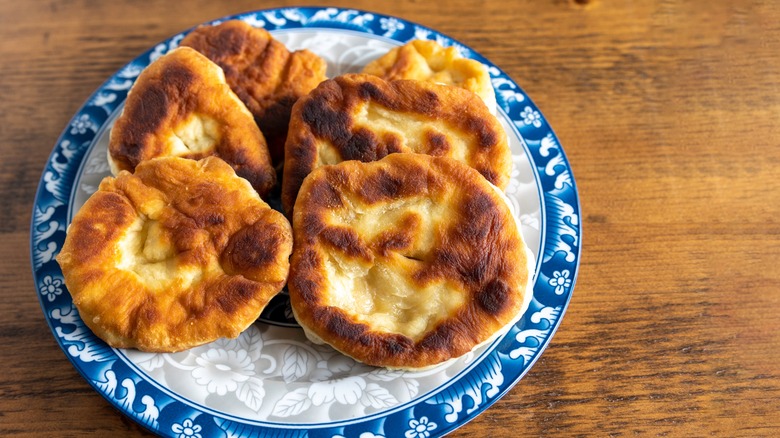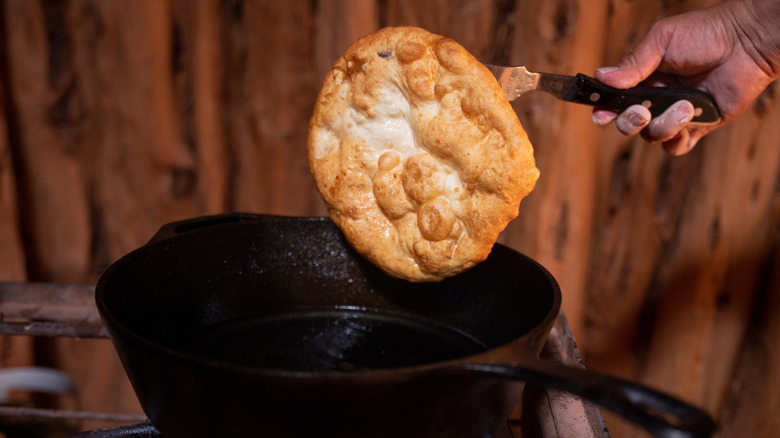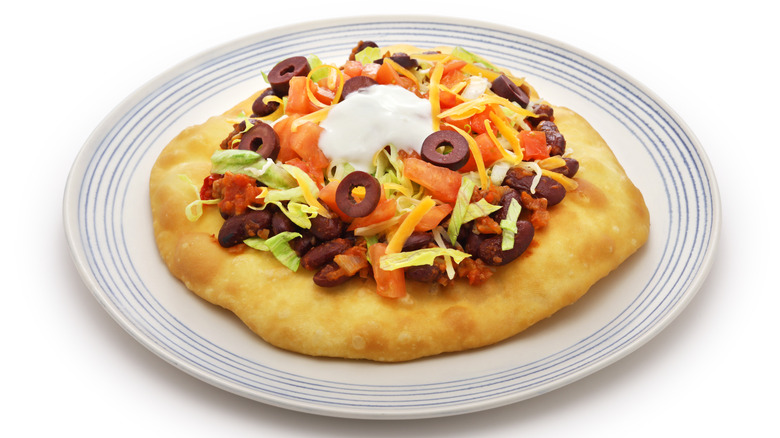Bannock Bread Is Peak Canadian Cuisine
To many folks outside of the country, Canada's cuisine is synonymous with popular exports like poutine, maple syrup, and Canadian bacon. However, if you take a visit to the Great White North, you'll discover hidden gems like the iconic bannock bread. Bannock is a simple, straightforward flatbread that doesn't look exciting, but is undoubtedly a must-try staple: filling, tasty, and with an important place in Canada's history.
Historians believe that bannock came to Canada from Scottish fur traders in the 18th or 19th centuries. The Scottish originally made the bread with oatmeal or peameal. It was easy to prepare, traveled well, and provided plenty of calories and carbs, making it perfect for long journeys and treacherous treks through the wilderness. Settlers arriving in Canada introduced bannock to the nation's indigenous peoples, who adopted the simple flatbread. However, there is evidence suggesting that indigenous groups already had their own versions of dense, flat breads cooked over an open fire, often made from a plant called camas.
Bannock in all of its iterations remains an important part of Canada's gastronomic culture, particularly among First Nations people. Today, the bread has become more of a fixture at restaurants and other vendors, but the exceedingly simple process of making it hasn't changed much.
Bannock is simple but significant
Modern bannock is usually made with wheat flour, which was introduced to Canada by European settlers. Before wheat flour arrived in the country, flatbreads made by native peoples varied in ingredients, but all used native crops such as the aforementioned camas bulb or corn. Today, basic bannock dough is made by mixing flour with water and fat, like lard or oil. Milk, seasonings, and sugar are often added for flavor, but none of these are integral to the basic recipe.
The dough is mixed together and formed into round or scone-like shapes, then baked in a pan. The baking process was originally done over an open fire, and this traditional method is still popular among those who love the great outdoors. The result is a fairly dense and plain bread, but bannock can also be fried for a lighter and airier texture. The popular Canadian treats called Beaver Tails are reminiscent of a fried variation of bannock, topped with sweet or savory fixings.
Bannock is still a celebrated food amongst the indigenous populations of Canada, and was historically served at festivals and celebrations. It can now also be found at food trucks and restaurants across the nation. Some eateries built around bannock use the bread as a base for burgers, tacos, breakfast sandwiches, and pastries. You'll even find bannock in some higher-end restaurants, but no matter how the bread is spiffed up, its historical significance must be remembered.
Bannock's complicated history turns a new leaf
The subject of bannock as a revered food of native Canadians can be a difficult one. Indigenous peoples did not begin making the European wheat bread in place of their own recipes simply because they chose to. Wheat-based bannock can be a reminder of the ways in which foreign settlers displaced domestic populations, changing their practices, beliefs, and styles of living, including their cuisine.
When native Canadians were pushed out of their lands and onto reserves, they could no longer forage and hunt in the way they had always known. They were given unfamiliar ingredients and supplies from the Canadian government, like flour, lard, sugar, and eggs, and had to adapt to avoid starvation. Hardy, filling, and simple bannock was an easy way to use and consume these foreign ingredients, becoming a staple of survival for indigenous peoples.
All of that being said, many indigenous residents of Canada are now turning the tradition of bannock into profitable businesses. A increasing number of indigenous-owned eateries in cities like Winnipeg, Toronto, and Edmonton sell bannock bread in many forms. One British Columbia-based chain called Kekuli Cafe even boasts the tagline, "Don't panic, we have bannock!". These new businesses are carving out a new, reclamation-forward space for bannock in modern Canadian cuisine.



